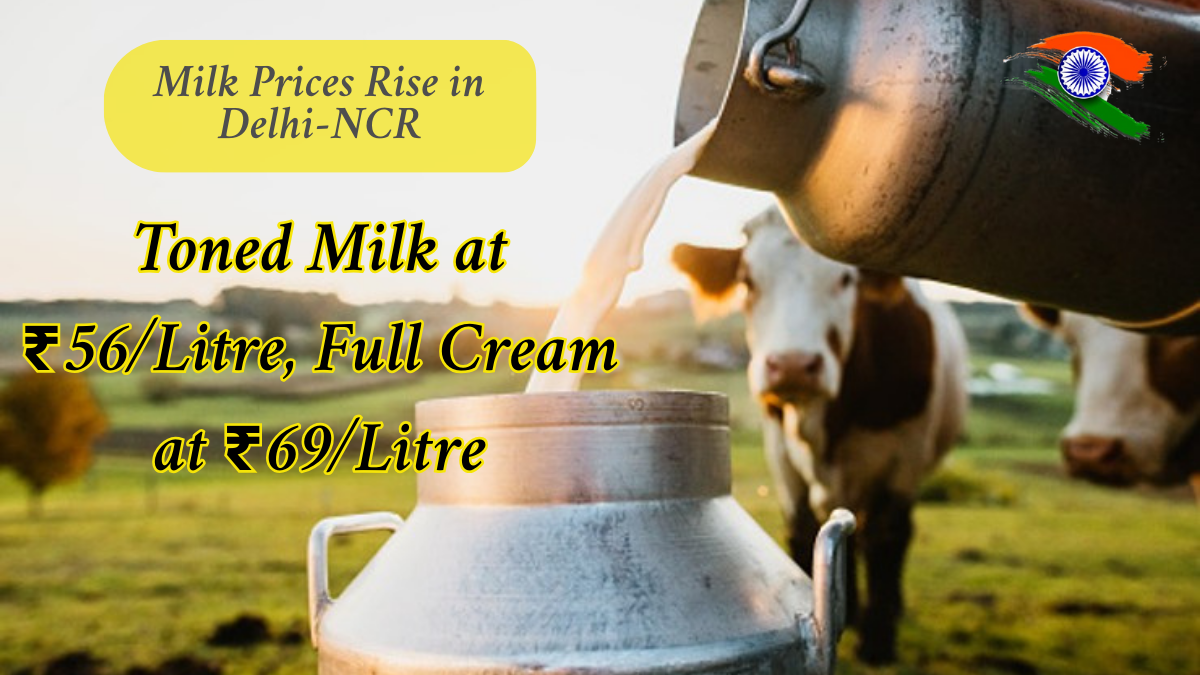In a move that impacts millions of households across Delhi-NCR, Mother Dairy has announced another milk price hike, effective April 30, 2025. The prices of various milk variants, including toned, full cream, double toned, and cow milk, have been raised by ₹1–₹2 per litre.

The company attributes the price increase to a sustained rise in procurement costs and production challenges due to heat stress on livestock. With this hike, the burden on consumers—already grappling with high food inflation—grows further.
Table of Contents
Summary Table: Mother Dairy Milk Price Changes – April 2025

Milk Variant |
Previous Price (₹/Litre) |
New Price (₹/Litre) |
Change |
|---|---|---|---|
Toned Milk (Bulk Vend) |
₹54 |
₹56 |
+ ₹2 |
Toned Milk (Pouch) |
₹56 |
₹57 |
+ ₹1 |
Full Cream Milk (Pouch) |
₹68 |
₹69 |
+ ₹1 |
Double Toned Milk |
₹49 |
₹51 |
+ ₹2 |
Cow Milk |
₹57 |
₹59 |
+ ₹2 |
Effective Date: April 30, 2025
Region: Delhi-NCR
Source: Mother Dairy Official Website
Why the Price Hike?
According to Mother Dairy officials, the primary reason for this price revision is the sharp increase in procurement cost. Here’s a breakdown:
- Rising input costs: Feed, fodder, veterinary services, and transport expenses have all gone up.
- Payment to farmers: The company has increased the rate paid to farmers by ₹4–₹5 per litre in recent months.
- Impact of heatwave: Unseasonal heat has negatively affected milk production, putting additional pressure on supply chains.
- Sustained loss absorption: Despite rising costs, Mother Dairy delayed the hike until now to minimize consumer impact.
Official Statement:
“We are committed to ensuring the uninterrupted supply of quality milk to consumers while also safeguarding the livelihood of dairy farmers. The recent heatwave and rise in input costs have compelled us to revise prices slightly.” — Mother Dairy Spokesperson
Impact on Consumers
Daily Household Budgets
For an average family consuming 2–3 litres of milk daily, the price hike will lead to an increased monthly milk expense of ₹60–₹180, depending on the type of milk consumed.
Food & Beverages Sector
Restaurants, cafes, tea stalls, and caterers are also expected to adjust menu prices, passing the cost to end consumers. Milk-based products like tea, coffee, paneer, curd, and sweets may become marginally more expensive.
Impact on Dairy Farmers
While consumers face higher prices, the hike also signals better remuneration for dairy farmers:
- Farmers are now being paid closer to ₹38–₹40 per litre, compared to ₹33–₹35 earlier.
- This adjustment helps them cope with inflation in animal feed and maintenance.
Dairy farmers form a critical part of India’s rural economy, and sustained support helps stabilize production and supply in the long term.
Mother Dairy’s Market Role
- Daily sales volume: Over 3.5 million litres per day in Delhi-NCR.
- Distribution: Operates through 1,800+ booths, general trade, and e-commerce platforms.
- Product range: Includes full cream, toned, double toned, cow milk, curd, paneer, lassi, ghee, and more.
Mother Dairy is a wholly owned subsidiary of the National Dairy Development Board (NDDB) and plays a central role in urban milk supply.
Milk Price Trends in India
Historical Perspective:
- Milk prices in India have risen steadily over the last decade, largely due to:
- Growing demand in urban areas.
- Declining productivity during harsh weather.
- Higher operational costs.
Comparison with Other Brands:
- Amul, another major dairy brand, also revised prices earlier this year.
- In most metros, the price of toned milk now ranges from ₹56–₹60/litre, depending on the brand and region.
Government and Regulatory Position
While milk prices are not directly controlled by the government, the dairy sector receives support through:
- Subsidies on cattle feed.
- Veterinary health support programs.
- Encouragement of co-operative dairy structures.
Consumer forums have occasionally demanded greater price transparency and standardized pricing mechanisms, but pricing remains a market-driven decision based on procurement and input dynamics.
FAQs: Milk Price Hike April 2025
Q1. Why has Mother Dairy increased milk prices?
A: Due to higher procurement costs, feed inflation, and the impact of heat stress on milk production.
Q2. Are other dairy brands also raising prices?
A: Yes. Most leading brands adjust prices periodically to reflect changes in procurement and operational costs.
Q3. Will prices reduce if production increases in cooler months?
A: Price reductions are rare and depend on long-term surplus. Temporary increases are more common during production dips.
Q4. Is government intervention possible?
A: Unlikely. Milk pricing is deregulated and determined by market factors and co-operative pricing structures.
Q5. Where can I check official price lists or changes?
A: Visit the official Mother Dairy website: https://www.motherdairy.com
Final Thoughts
Milk is a staple in Indian households, and even a small price increase has ripple effects on daily budgets. While the hike by Mother Dairy is modest, it reflects ongoing challenges in the dairy supply chain, including rising production costs and climate stress.
For consumers, budgeting for essential items like milk becomes a tighter task. For the dairy industry, ensuring fair farmer compensation and consistent supply remains the priority.
As climate conditions and input costs evolve, more price adjustments may be expected in the near future.
Click Here To Know More







